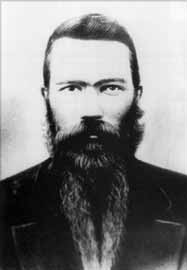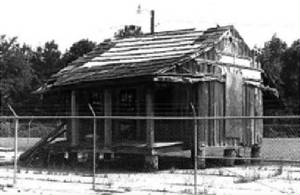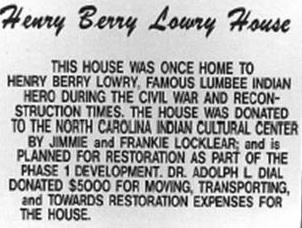|
Henry Berry Lowry
Henry Berry Lowry (aka Henry Berry Lowrie)
Born ca. 1844; last seen in 1872; date of death unknown.
Henry Berry Lowry Lives Forever
| Henry Berry Lowry |

|
| (NCOAH) |
Although the Confederate Army
recruited the Cherokee Indians from western North Carolina, it refused to recruit the Lumbee Indians
from the eastern part of the state. While the Cherokee in the U.S. 1860 census was designated as "Indian," the Lumbee,
on the other hand, was referred to as "black" or "mulatto."
On a hot June day in 1999, a young
Lumbee Indian man, Randall Oxendine, stood on the banks of the old millpond at Bear Swamp and yelled, “I’m gonna
get you, Henry Berry!” Gabrial Cummings looked at him and asked what Randall would do if Henry Berry came floating down
that swamp in his flat-bottomed boat with his rifle across his knee. Randall, Gabrial, and I all laughed nervously, wondering
if or when Henry Berry Lowry would come paddling down that swamp. We all looked to see if he was there. . . .
Henry Berry Lowry was the legend
of Robeson County*
even before he vanished in February 1872. He disappeared after he stole the safes from Pope and McLeod’s store and from
the sheriff’s office in Lumberton. He broke open the
sheriff’s safe and left it lying in the middle of a Lumberton
street. In all, he stole $28,000. Three days later he vanished. The New York Herald published reports that Henry Berry Lowry
had accidentally killed himself. An elderly Lumbee man, John Godwin, said that Henry Berry Lowry “had been trying to
shoot the load off his gun for a long time. . . .
The load went right up through here, my mother said, and blowed the top of his head off.” This and
other local legends were recorded by Lumbee historian and teacher Adolph Dial in the 1960s and 1970s. The many legends differ
in their account of Lowry’s disappearance. A ninety-six-year-old Lumbee man, Mabe Sampson, believed that Henry Berry
Lowry escaped from the militia and the United States troops who were trying to track him down. Mr.
Sampson said that “Henry Berry left here and was sent off by a white man, loaded right here at Moss Neck. He never was
killed.”
| Henry Berry Lowry Home |

|
| (NCOAH) |
Henry Berry Lowry was one
of twelve children in the family of Allen and Mary Lowry. The Lowrys struggled, as did
other Indians in Robeson County, through the hard times that
the Civil War brought them. During the war, the Confederacy forced Lumbees to work on building the earthen Fort Fisher near Wilmington.
At home, the Home Guard accused Indians of harboring escaped Union prisoners and Confederate deserters, hiding guns, and stealing
meat from smokehouses. The Home Guard supported the Confederacy and maintained law and order at home while the war
was being fought. Indian men had to resort to “lying out”—or hiding—in the swamps to avoid being harassed
and rounded up by the Home Guard.
Henry Lowry had had
enough of being controlled and pushed around by the local Home Guard authority, so he struck back. He killed James P. Barnes
on December 21, 1864, and James Brantley “Brant” Harris on January 15, 1865. The Lowry family had had ongoing
disputes with both men. The Home Guard avenged the deaths of James Barnes and Brant Harris by accusing Henry Lowry’s
father, Allen, and brother William of various crimes. The Home Guard convened an illegal court. They tried, convicted, and
executed Allen and William in one day, March 3, 1865. Eighteen-year-old Henry reportedly watched the executions from behind
some bushes. He swore to take revenge for their deaths.
| Henry Berry Lowry House |

|
| Historical Marker |
Henry was a wanted man. "He
lay out in the swamps but was arrested (with no warrant) for murder by the Home Guard on December 7, 1865, at his wedding
to Rhoda Strong." Mary Norment, author of The Lowrie History, says that after his arrest “he filed his way out of the
grated iron window bars, escaped to the woods with handcuffs on, and made his way back to his wife in Scuffletown [Pembroke].”
Henry had gathered
around him other Indian men who had tired of taking the mistreatment of whites. Along with this group, two African Americans
and one white “buckskin” Scot joined what became known as the Lowry band. The band robbed rich white landowners,
and Henry became the “Robin Hood” of Robeson County.
The governor outlawed Henry Berry Lowry and the band in 1869, offering large rewards for them, dead or alive. The band responded
with violence. In one ten-month stretch, ten Police Guard and Lowry band members died.
In 1871, Francis Marion
Wishart became colonel of the Police Guard manhunt and had the wives of the Lowry band held hostage in prison. Henry and
other band members sent Wishart a letter demanding the release of their wives, or “the bloodiest times will be here
than ever was before—the life of every man will be in jeopardy.” The wives were released, and Colonel Wishart
and the government began to work out an end to the conflict. The killing soon stopped, and, in February 1872, Henry Berry
Lowry vanished. Colonel Wishart called the reports of his death “ALL A HOAX.” No one ever collected the $12,000
reward for his life.
Many years after he vanished,
Henry reportedly was seen in a church at a funeral for someone he knew. No one talked to him, and he talked to no one,
but Robeson County
resident Charlie McBryde says that “They said had you looked at his eyes good, you would have known it was Henry Berry.”
Today, reminders of Henry are all around the area, with a road named after him and a play portraying his life. Henry
Berry Lowry has lived on in the minds and hearts of the Lumbee.
If you are ever in Robeson County,
go down to the swamps and be still. You can feel him, and if you look real close, you might even see him.
Adapted from Jefferson Currie's article in the Tar
Heel Junior Historian 39 (spring 2000).
Jefferson Currie is Lumbee.
At the time of this article’s publication, he was an assistant curator at the North Carolina Museum of History who worked
on the Henry Berry Lowry portion of the exhibit "North Carolina Legends."
*Robeson County and the Lumbee Indians
| Robeson County, North Carolina |

|
| Lumbee |
The Lumbee Indians, most of who reside in Robeson County, constitute the largest group of Native
Americans in eastern North Carolina. Although their exact origin is a complex matter, they are undoubtedly the descendants
of several tribes, which occupied eastern Carolina during the earliest days of white settlement. Living along the Pee Dee
and Lumber Rivers in present-day Robeson and adjacent counties, these Native Americans of mixed blood were officially designated
as Lumbees by the General Assembly in 1956. During the Civil War, Robeson County Indians, having been classified with "free
Negroes, free mulattos, or free persons of mixed blood" in the disfranchisement amendment to the North Carolina Constitution
in 1835, were then prohibited from bearing arms. They were conscripted for service on Confederate fortifications near Wilmington
to labor side-by-side with slaves. Discontented and humiliated, a number of Lumbees escaped into the swamps of Robeson County
where they formed the nucleus of a band under the leadership of Henry Berry Lowry. Using familiar swamplands as their hideout,
they remained an outlaw band for more than seven years. Although the records of Robeson County contain much material relating
to the Lumbee Indians, certain identification of Lumbees in the county archives is not always possible. Most of the Native
Americans have Anglo-Saxon names and they are generally designated as "black" or "mulatto" in nineteenth-century documents;
for example, in the U.S. Censuses of 1850-1880, the designation for Lumbee families is usually "mulatto.” Nevertheless,
a few common Lumbee family names, which appear frequently in the county records are likely to represent Indian individuals,
especially when such names are found in records originating in Scuffletown (present-day Pembroke) and Lumberton.
Some common Lumbee family names are Bullard, Chavis, Comboes, Dial, Drinkwater, Harding, Locklear, Lowry,
Oxendine, and Sampson.
Recommended Reading:
To Die Game: The Story of the Lowry Band, Indian Guerrillas of Reconstruction
(Iroquois and Their Neighbors). Description: During the Civil War, many young Lumbee Indians of North Carolina hid in the
swamps to avoid conscription into Confederate labor battalions and were compelled to conduct a guerrilla war. This is the
story of Henry Berry Lowry, a Lumbee, who killed a Confederate official, escaped, and commanded a guerrilla gang.
Related Reading:
Recommended
Viewing: Indian Warriors - The Untold Story of the Civil
War (History Channel) (2007). Description:
Though largely forgotten, 20 to 30 thousand Native Americans fought in the Civil War. Ely Parker was a Seneca leader who found
himself in the thick of battle under the command of General Ulysses S. Grant. Stand Watie--a Confederate general and a Cherokee--was known for his brilliant guerrilla tactics.
Continued below...
Also highlighted is Henry Berry Lowery,
an Eastern North Carolina Indian, who became known as the Robin Hood of North Carolina. Respected Civil War authors, Thom
Hatch and Lawrence Hauptman, help reconstruct these most captivating stories, along with descendants like Cherokee Nation
member Jay Hanna, whose great-grandfathers fought for both the Union and the Confederacy. Together, they reveal a new, fresh perspective and the very
personal reasons that drew these Native Americans into the fray.
Recommended Reading:
The Only Land I Know: A History of the Lumbee Indians (The Iroqouis and Their Neighbors).
Description: Written from an Indian perspective, this text provides a history of the Lumbee Indians of southwestern
North Carolina. Sections cover: the colonial period and
the Revolutionary War; the Lowrie War; the development of the Lumbee educational system; Lumbee folklore; and the modern Lumbee.
Recommended Reading:
The Lumbee Problem: The Making of an American Indian People. Description:
How does a group of people who have American Indian ancestry but no records of treaties, reservations, Native language, or
peculiarly "Indian" customs come to be accepted—socially and legally—as Indians? Originally published in 1980,
The Lumbee Problem traces the political and legal history of the Lumbee Indians of Robeson County, North Carolina, arguing
that Lumbee political activities have been powerfully affected by the interplay between their own and others' conceptions
of who they are. Continued below…
The book offers insights into
the workings of racial ideology and practice in both the past and the present South—and particularly into the nature
of Indianness as it is widely experienced among nonreservation Southeastern Indians. Race and ethnicity, as concepts and as
elements guiding action, are seen to be at the heart of the matter. By exploring these issues and their implications as they
are worked out in the United States, Blu brings much-needed clarity to the question of how such concepts are—or should
be—applied across real and perceived cultural borders. Reviews: "The work
is authoritative, theoretically provocative, and accessibly written, and should stand as a definitive source on the Lumbee
for some time, as well as a useful contribution to the understanding of the South." - Choice
"A
welcome and valiant effort to elaborate on a quasi-comprehensive basis the history and contemporary status of this indigenous
group... It ranks high on the small list of works dealing with an Eastern tribe minus a treaty relationship with the federal
government." - Ethnohistory
Recommended Reading: The Swamp Outlaw: The Civil War Story
of Henry Berry Lowery and His North Carolina Indian Raiders. Description: This is a story beautifully
written by Davis Ball. Although Ball is not a Native American, he captured the spirit of the War torn south in Robeson
County, N.C. during the Civil War.
NEW!
Recommended Viewing: We Shall Remain (PBS) (DVDs) (420 minutes). Midwest Book Review: We Shall Remain is a three-DVD thinpack set
collecting five documentaries from the acclaimed PBS history series "American Experience", about Native American leaders including
Massasoit, Tecumseh, Tenskwatawa, Major Ridge, Geronimo, and Fools Crow, all who did everything they could to resist being
forcibly removed from their land and preserve their culture. Continued below…
Their strategies
ranged from military action to diplomacy, spirituality, or even legal and political means. The stories of these individual
leaders span four hundred years; collectively, they give a portrait of an oft-overlooked yet crucial side of American history,
and carry the highest recommendation for public library as well as home DVD collections. Special features include behind-the-scenes
footage, a thirty-minute preview film, materials for educators and librarians, four ReelNative films of Native Americans sharing
their personal stories, and three Native Now films about modern-day issues facing Native Americans. 7 hours. "Viewers will
be amazed." "If you're keeping score, this program ranks among the best TV documentaries ever made." and "Reminds us that
true glory lies in the honest histories of people, not the manipulated histories of governments. This is the stuff they kept
from us." --Clif Garboden, The Boston Phoenix.
|

